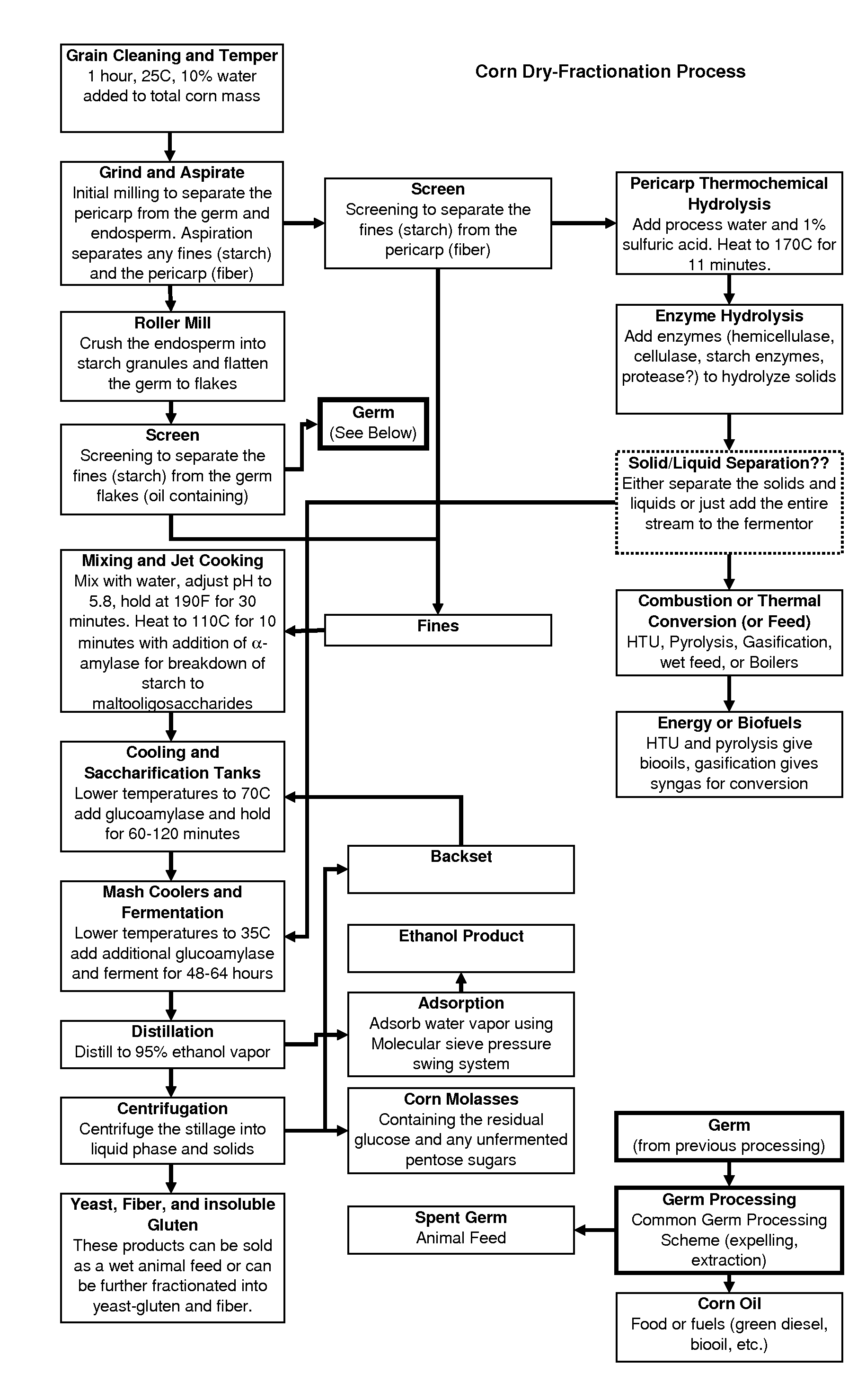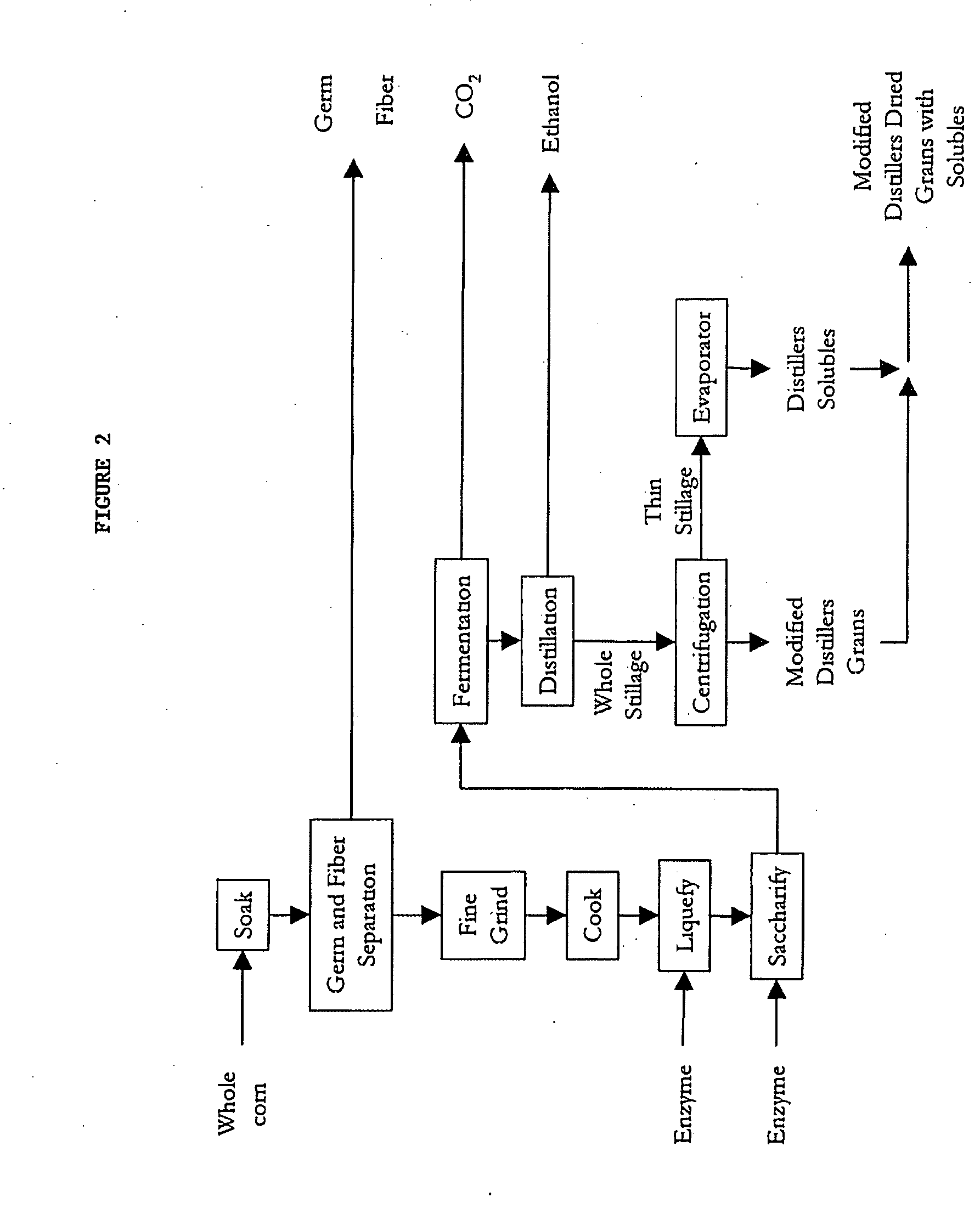Dry fractionation of corn
a technology of dry fractionation and corn, which is applied in the field of corn product production, can solve the problems of reduced operation efficiency, high oil content that is relatively difficult to extract, and low value of non-ethanol byproducts (including ddg), and achieve the effect of increasing the yield of ethanol
- Summary
- Abstract
- Description
- Claims
- Application Information
AI Technical Summary
Benefits of technology
Problems solved by technology
Method used
Image
Examples
example 1
[0059]Corn milling tests have been conducted on dry fractionation of corn kernels at ADM. This run consisted of placing 5 kg of corn kernels in a rotating sealed vessel and adding 10% water. The vessel was rotated for 1 hour at room temperature and then the kernels were removed. The tempered corn kernels were roughly ground through a Fitz Comminutor fitted with a ¼″ screen; followed by aspiration through a Kice aspirator with a 1 inch of water differential; the “overs” and “throughs” from the aspirator were sieved in a Sweco shaking screener at 6, 12, and 20 mesh sizes. After sieving, the intermediate particles (−6 / +20) from the “throughs” were roller milled twice at a gap setting of 1.1 on the Ferrell-Ross Flaking roller mill and then sieved in a Sweco shaking screener at 6 and 12 mesh sizes. The fines (20 mesh or below, −20) were combined prior to analysis. This produced 6 fractions as shown in Table 1 below. With the exception of the pericarp and the germ, the remaining listed co...
example 2
[0064]Example 2 describes the separation and utilization of the liquids and solids from the hydrolyzed pericarp stream. After the sulfuric acid hydrolysis of the pericarp fraction as described in Example 1, the hydrolyzed pericarp slurry is processed using a screw press or centrifuge to separate the solids and liquid. For example a Vincent screw press model CP-4 could be utilized to separate the solids and liquids. The solids can be washed in the press or centrifuge also to remove more soluble oligosaccharides and monosaccharides from the remaining hydrolyzed solids.
[0065]The separated liquid from the hydrolyzed pericarp slurry can be hydrolyzed again with an additional acid hydrolysis or with an enzyme hydrolysis. This will break down the soluble starch and hemicellulose oligosaccharides to monosaccharides that can be fermented to ethanol or other chemicals. The conditions for the acid hydrolysis are 121° C. (approximately 2 bar) for 30 minutes. The conditions for the enzyme hydrol...
example 3
[0067]Example 3 reports an additional embodiment of the invention, the flow chart for which may be viewed as FIG. 6. The corn was tempered for 15 to 60 minutes and milled as described in Example 1 above. Then the ground corn was aspirated in a Kice aspirator at a differential pressure of 0.75 inches of water. The light fraction or overs were sieved in a Sweco shaking screener using a U.S. standard sieve size of 12. The +12 fraction consists of the pericarp fraction (Fiber Fraction, Product 1, in FIG. 6) and the −12 fraction consists of an endosperm fraction (Starch Fraction, Product 2, in FIG. 6).
[0068]The heavys or throughs were then aspirated again at 2.9 inches of water and the heavy fraction was an endosperm fraction (Starch Fraction, Product 3, in FIG. 6). The lights were sieved in a Sweco sieving screen using U.S. standard sieve sizes of 6 and 10. The +6 fraction was the germ fraction (Germ Fraction, Product 6, in FIG. 6), and the other two fractions were endosperm fractions (...
PUM
| Property | Measurement | Unit |
|---|---|---|
| temperature | aaaaa | aaaaa |
| temperature | aaaaa | aaaaa |
| temperature | aaaaa | aaaaa |
Abstract
Description
Claims
Application Information
 Login to View More
Login to View More - R&D
- Intellectual Property
- Life Sciences
- Materials
- Tech Scout
- Unparalleled Data Quality
- Higher Quality Content
- 60% Fewer Hallucinations
Browse by: Latest US Patents, China's latest patents, Technical Efficacy Thesaurus, Application Domain, Technology Topic, Popular Technical Reports.
© 2025 PatSnap. All rights reserved.Legal|Privacy policy|Modern Slavery Act Transparency Statement|Sitemap|About US| Contact US: help@patsnap.com



